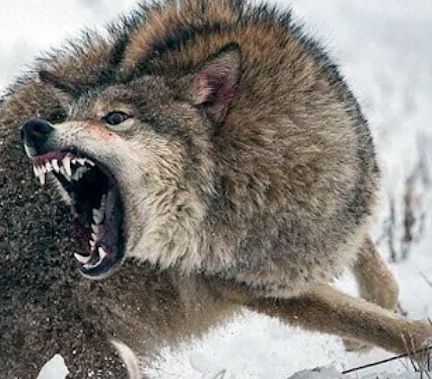The Mysterious Blessing of Purpose
Wolves are fascinating creatures, and even more so due to the recent changes to their population in North America.
In 1995, grey wolves were reintroduced into Yellowstone National Park. Knowing that wolves are predators and typically at the top of the food chain, common expectation was that elk, beaver, rabbit, and other prey populations might decrease due to the predatory prowess of the wolves — you know, the whole "circle of life" effect.

But the reverse has actually been the case. There was only one beaver colony in the park in 1995, but by 2019 there were nine colonies! What possible impact did the reintroduction of wolves have on the beaver population? Well, as the wolves chased the elk they began moving around more, spreading throughout the park. This disbursement of the elk population allowed beavers and other animals to enjoy a greater share of the vegetation they need to eat for survival. And since the beavers were now able to not just survive, but to thrive, they built more dams, which in turn has benefitted the fish, bird, and bear populations.
... [T]he reintroduction of wolves continues to astonish biologists with a ripple of direct and indirect consequences throughout the ecosystem. ... It is like kicking a pebble down a mountain slope where conditions were just right that a falling pebble could trigger an avalanche of change. — Doug Smith, a wildlife biologist in charge of the Yellowstone Wolf Project
You see how this works? What was feared as an irritant, a disruptor, a destroyer, was actually a catalyst for immensely powerful and positive change.
Just as wolves have their place in the economy of wildlife ecology, they likewise have their place in the economy of the Kingdom.
For example, Saul of Tarsus perceived the bold and fearless testimony of Stephen as a wolf, an irritant, a disruptor, a threat to the status quo of Jewish life and culture. So he had him stoned to death. Yet in doing so, he didn't protect anything. Instead, Acts 8:1-4 tells us:
"On that day a great persecution broke out against the church in Jerusalem, and all except the apostles were scattered throughout Judea and Samaria. Godly men buried Stephen and mourned deeply for him. But Saul began to destroy the church. Going from house to house, he dragged off both men and women and put them in prison."
YET! ...
"Those who had been scattered preached the word wherever they went."
This great irritant, this great disruption to the status quo, proved instead to be the catalyst for the early believers to be scattered, and for the Gospel message to be spread and thrive throughout the entire known world.
On the flip side of that coin, the Church perceived Saul of Tarsus as a wolf, a great irritant, and disrupter of the survival of the fledgling Church. Yet the events following the death of Stephen became part of the amazing story of the transformation of Saul of Tarsus into the Apostle Paul, the Apostle to the Gentiles, whose life and ministry remains one of the greatest catalysts for the growth of the Church even to this day.
Brothers, in this world there WILL be wolves. Don't run in fear from them. Embrace the struggle. See the struggle as potential for great personal, and even corporate growth. Just as the introduction of the wolves into the park forced the animals to spread out, the disruption brought greater growth and potential. So, along with that Yellowstone biologist, choose to see the potential from the struggle with disruptors as "a ripple of direct and indirect consequences throughout the ecosystem."
Opposable Digits Are Anything But
Many (particularly naturalists) would argue that science and faith enjoy ZERO compatibility. But is it true that science and faith must be so diametrically opposed to one another?
Consider opposable digits. They are wondrous things. Most primates have them. But mans’ thumbs are uniquely designed for ultimate coordination:
The human opposable thumb is longer, compared to finger length, than any other primate thumb. This long thumb and its ability to easily touch the other fingers allow humans to firmly grasp and manipulate objects of many different shapes. The human hand can grip with strength and with fine control, so it can throw a baseball or sign a name on the dotted line.

So what do opposable digits have to do with the marriage of science and faith? Well, the noted scientist and winner of the Nobel Prize for Physics 1915, Sir William Bragg, made this astute connection …
Christianity and science are opposed … but only in the same sense as that which my thumb and forefinger are opposed — and between them, I can grasp everything.
Science and faith do not oppose one another. They fully and completely compliment one another. Science declares the heights and depths and intricacies of God’s creative powers, while faith gives reason to all of it.
“Great are the works of the Lord, studied by all who delight in them” (Psalms 111:2, ESV).
“For his invisible attributes, namely, his eternal power and divine nature, have been clearly perceived, ever since the creation of the world, in the things that have been made. So they are without excuse” (Romans 1:20, ESV).
“The heavens declare the glory of God, and the sky above proclaims his handiwork” (Psalms 19:1, ESV).
The Glue That Holds Us Together
Ever wonder how our body stays neatly contained within the confines of our cells and organs? Well, you can thank Laminins for that little piece of biological magic!
Laminins are large molecular weight glycoproteins constituted by the assembly of three disulfide-linked polypeptides, the α, β and γ chains. The human genome encodes 11 genetically distinct laminin chains. Structurally, laminin chains differ by the number, size and organization of a few constitutive domains, endowing the various members of the laminin family with common and unique important functions. In particular, laminins are indispensable building blocks for cellular networks physically bridging the intracellular and extracellular compartments and relaying signals critical for cellular behavior, and for extracellular polymers determining the architecture and the physiology of basement membranes.
Basement membranes are specialized extracellular matrices holding cells and tissues together, a property largely due to their content in laminins.
In short, laminims are what scientists refer to as "adhesion" molecules. They are the molecular glue which hold our very beings together.

Molecular biologists call laminin “the glue of the body,” because without it, our bodies would fall apart. With that said, note the specific appearance of this critical molecule.
Some have suggested that it is no coincidence that laminin molecules arrange themselves into the shape of a cross.
The truth is, without Jesus and what he did for us on the cross, our whole lives would fall apart. Colossians 1:17 says that Jesus “is before all things, and in him all things hold together.”
"For in him we live and move and have our being" (Acts 17:28, NIV).
Jesus is the one who holds all things together!